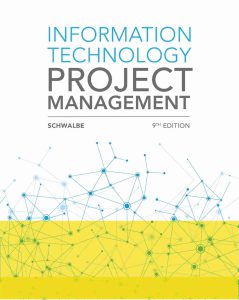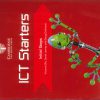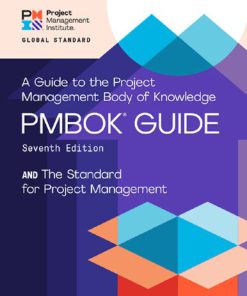Information Technology Project Management 9th Edition by Kathy Schwalbe 9781337101356 1337101354
$50.00 Original price was: $50.00.$25.00Current price is: $25.00.
Information Technology Project Management 9th Edition Schwalbe – Ebook Instant Download/Delivery ISBN(s): 9781337101356, 1337101354

Product details:
- ISBN 10: 1337101354
- ISBN 13:9781337101356
- Author: Kathy Schwalbe
Information Technology Project Management
Table contents:
Chapter 1. Introduction to Project Management
Introduction
What Is a Project?
Examples of IT Projects
Project Attributes
Project Constraints
What Is Project Management?
Project Stakeholders
Project Management Knowledge Areas
Project Management Tools and Techniques
Project Success
Program and Project Portfolio Management
Programs
Project Portfolio Management
Organizational Project Management
The Role of the Project Manager
Project Manager Job Description
Suggested Skills for Project Managers
PMI Talent Triangle® and the Importance of Leadership Skills
Careers for IT Project Managers
The Project Management Profession
History of Project Management
The Project Management Institute
Project Management Certification
Ethics in Project Management
Project Management Software
Chapter Summary
Discussion Questions
Quick Quiz
Exercises
Key Terms
Chapter 2. The Project Management and Information Technology Context
A Systems View of Project Management
What Is a Systems Approach?
The Three-Sphere Model for Systems Management
Understanding Organizations
The Four Frames of Organizations
Organizational Structures
Organizational Culture
Focusing on Stakeholder Needs
The Importance of Top Management Commitment
The Need for Organizational Commitment to Information Technology
The Need for Organizational Standards
Project and Product Life Cycles
Project Life Cycle
Product Life Cycles
The Importance of Project Phases and Management Reviews
The Context of Information Technology Projects
The Nature of IT Projects
Characteristics of IT Project Team Members
Diverse Technologies
Recent Trends Affecting Information Technology Project Management
Globalization
Outsourcing
Virtual Teams
Agile
Chapter Summary
Discussion Questions
Quick Quiz
Exercises
Key Terms
Chapter 3. The Project Management Process Groups
Project Management Process Groups
Mapping the Process Groups to the Knowledge Areas
Developing an IT Project Management Methodology
Case Study 1: JWD Consulting’s Project Management Intranet Site Project (Predictive Approach)
Project Pre-Initiation and Initiation
Pre-Initiation Tasks
Initiating
Project Planning
Project Execution
Project Monitoring and Controlling
Project Closing
Case Study 2: JWD Consulting’s Project Management Intranet Site Project (Agile Approach)
Scrum Roles, Artifacts, and Ceremonies
Project Pre-Initiation and Initiation
Planning
Executing
Monitoring and Controlling
Closing
Templates by Process Group
Chapter Summary
Discussion Questions
Quick Quiz
Exercises
Key Terms
Chapter 4. Project Integration Management
What is Project Integration Management?
Strategic Planning and Project Selection
Strategic Planning
Identifying Potential Projects
Aligning IT with Business Strategy
Methods for Selecting Projects
Focusing on Broad Organizational Needs
Categorizing IT Projects
Performing Financial Analyses
Using a Weighted Scoring Model
Implementing a Balanced Scorecard
Developing a Project Charter
Developing a Project Management Plan
Project Management Plan Contents
Using Guidelines to Create Project Management Plans
Directing and Managing Project Work
Coordinating Planning and Execution
Providing Strong Leadership and a Supportive Culture
Capitalizing on Product, Business, and Application Area Knowledge
Project Execution Tools and Techniques
Managing Project Knowledge
Monitoring and Controlling Project Work
Performing Integrated Change Control
Change Control on IT Projects
Change Control System
Closing Projects or Phases
Using Software to Assist in Project Integration Management
Considerations for Agile/Adaptive Environments
Chapter Summary
Discussion Questions
Quick Quiz
Exercises
Running Case
Key Terms
Chapter 5. Project Scope Management
What is Project Scope Management?
Planning Scope Management
Collecting Requirements
Defining Scope
Creating the Work Breakdown Structure
Approaches to Developing Work Breakdown Structures
The WBS Dictionary
Advice for Creating a WBS and a WBS Dictionary
Validating Scope
Controlling Scope
Suggestions for Improving User Input
Suggestions for Reducing Incomplete and Changing Requirements
Using Software to Assist in Project Scope Management
Considerations for Agile/Adaptive Environments
Chapter Summary
Discussion Questions
Quick Quiz
Exercises
Running Case
Key Terms
Chapter 6. Project Schedule Management
The Importance of Project Schedules
Planning Schedule Management
Defining Activities
Sequencing Activities
Dependencies
Network Diagrams
Estimating Activity Durations
Developing the Schedule
Gantt Charts
Adding Milestones to Gantt Charts
Using Tracking Gantt Charts to Compare Planned and Actual Dates
Critical Path Method
Calculating the Critical Path
Growing Grass Can Be on the Critical Path
Using Critical Path Analysis to Make Schedule Trade-Offs
Using the Critical Path to Shorten a Project Schedule
Importance of Updating Critical Path Data
Critical Chain Scheduling
Program Evaluation and Review Technique (PERT)
Agile and Schedule Management
Controlling the Schedule
Reality Checks on Scheduling and the Need for Discipline
Using Software to Assist in Project Schedule Management
Words of Caution on Using Project Management Software
Considerations for Agile/Adaptive Environments
Chapter Summary
Discussion Questions
Quick Quiz
Exercises
Running Case
Key Terms
Chapter 7. Project Cost Management
The Importance of Project Cost Management
What Is Cost?
What Is Project Cost Management?
Basic Principles of Cost Management
Planning Cost Management
Estimating Costs
Types of Cost Estimates
Cost Estimation Tools and Techniques
Typical Problems with IT Cost Estimates
How to Develop a Cost Estimate and Basis of Estimates
Determining the Budget
Controlling Costs
Earned Value Management
Project Portfolio Management
Using Project Management Software to Assist in Project Cost Management
Considerations for Agile/Adaptive Environments
Chapter Summary
Discussion Questions
Quick Quiz
Exercises
Running Case
Key Terms
Chapter 8. Project Quality Management
The Importance of Project Quality Management
What Is Project Quality Management?
Planning Quality Management
Managing Quality
Controlling Quality
Tools and Techniques for Quality Control
Statistical Sampling
Six Sigma
Testing
Modern Quality Management
Deming and His 14 Points for Management
Juran and the Importance of Top Management Commitment to Quality
Crosby and Striving for Zero Defects
Ishikawa’s Guide to Quality Control
Taguchi and Robust Design Methods
Feigenbaum and Workers’ Responsibility for Quality
Malcolm Baldrige National Quality Award
ISO Standards
Improving It Project Quality
Leadership
The Cost of Quality
The Impact of Organizational Influences, and Workplace Factors on Quality
Expectations and Cultural Differences in Quality
Maturity Models
Using Software to Assist in Project Quality Management
Considerations for Agile/Adaptive Environments
Chapter Summary
Discussion Questions
Quick Quiz
Exercises
Running Case
Key Terms
Chapter 9. Project Resource Management
The Importance of Resource Management
The Global IT Workforce
Implications for the Future of IT Human Resource Management
What Is Project Resource Management?
Keys To Managing and Leading People
Motivation Theories
Influence and Power
Covey and Improving Effectiveness
Emotional Intelligence
Leadership
Developing the Resource Management Plan and Team Charter
Project Organizational Charts
Responsibility Assignment Matrices
Staffing Management Plans and Resource Histograms
Team Charters
Estimating Activity Resources
Acquiring Resources
Resource Assignment
Resource Loading
Resource Leveling
Developing the Project Team
Training
Team-Building Activities
Reward and Recognition Systems
Managing the Project Team
Tools and Techniques for Managing Project Teams
General Advice on Managing Teams
Controlling Resources
Using Software to Assist in Resource Management
Considerations for Agile/Adaptive Environments
Chapter Summary
Discussion Questions
Quick Quiz
Exercises
Running Case
Key Terms
Chapter 10. Project Communications Management
The Importance of Project Communications Management
Keys to Good Communications
Focusing on Group and Individual Communication Needs
Formal and Informal Methods for Communicating
Distributing Important Information in an Effective and Timely Manner
Setting the Stage for Communicating Bad News
Determining the Number of Communication Channels
Planning Communications Management
Managing Communications
Using Technology to Enhance Information Creation and Distribution
Selecting the Appropriate Communication Methods and Media
Reporting Performance
Monitoring Communications
Suggestions for Improving Project Communications
Developing Better Communication Skills
Running Effective Meetings
Using E-Mail, Instant Messaging, Texting, Kanban Boards, and Collaborative Tools Effectively
Using Templates for Project Communications
Using Software to Assist in Project Communications
Considerations for Agile/Adaptive Environments
Chapter Summary
Discussion Questions
Quick Quiz
Exercises
Running Case
Key Terms
Chapter 11. Project Risk Management
The Importance of Project Risk Management
Planning Risk Management
Common Sources of Risk on IT Projects
Identifying Risks
Suggestions for Identifying Risks
The Risk Register
The Risk Report
Performing Qualitative Risk Analysis
Using Probability/Impact Matrixes to Calculate Risk Factors
Top Ten Risk Item Tracking
Performing Quantitative Risk Analysis
Decision Trees and Expected Monetary Value
Simulation
Sensitivity Analysis
Planning Risk Responses
Implementing Risk Responses
Monitoring Risks
Using Software to Assist in Project Risk Management
Considerations for Agile/Adaptive Environments
Chapter Summary
Discussion Questions
Quick Quiz
Exercises
Running Case
Key Terms
Chapter 12. Project Procurement Management
The Importance of Project Procurement Management
Planning Procurement Management
Types of Contracts
Tools and Techniques for Planning Procurement Management
Procurement Management Plan
Statement of Work
Procurement or Bid Documents
Examples from a Real RFP
Source Selection Criteria
Conducting Procurements
Controlling Procurements
Using Software to Assist in Project Procurement Management
Considerations for Agile/Adaptive Environments
Chapter Summary
Discussion Questions
Quick Quiz
Exercises
Running Case
Key Terms
Chapter 13. Project Stakeholder Management
The Importance of Project Stakeholder Management
Identifying Stakeholders
Planning Stakeholder Engagement
Managing Stakeholder Engagement
Monitoring Stakeholder Engagement
Using Software to Assist in Project Stakeholder Management
Considerations for Agile/Adaptive Environments
Chapter Summary
People also search:
information technology project management
information technology project management 9th edition pdf
information technology project management pdf
international journal of information technology project management
information technology project management salary
You may also like…
Business & Economics - Management & Leadership
Uncategorized
Reference - Library & Information Science
Business & Economics - Project Management
Business & Economics - Management & Leadership
Healthcare Project Management Second Edition Schwalbe Kathy Furlong Dan
Business & Economics - Management & Leadership
Service Management: Operations, Strategy, Information Technology 10th Edition Sanjeev K. Bordoloi
Business & Economics - Project Management












